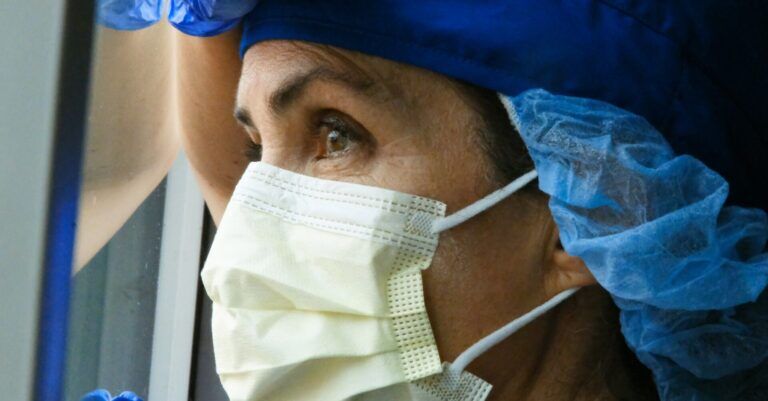Introduction
The main symptoms of coronavirus (Covid-19) are a high temperature, a new, continuous cough and a loss or change to your sense of smell or taste.1 In the last six months in the UK, as we learn more about coronavirus, other symptoms and signs have merged, mostly significantly skin manifestations.
A key epidemiological paper was published in June 2020, from a group of Spanish doctors, who carried out a nationwide case collection survey of images and clinical data on Covid-19 skin symptoms with 375 cases.2 This study identified and classified five clinical cutaneous patterns, which are described in this article. In addition, skin irritation, dermatitis and dryness is now very common, in people with previously healthy skin, as frequent hand washing and wearing of personal protective equipment (PPE) has rapidly increased these skin symptoms that also exacerbate chronic skin conditions.3 Nurses will be seeing patients with skin conditions and symptoms in the course of their daily practice, so have an important role to play in recognising potential Covid-19 skin signs. Nurses can then refer patients to their GP or local dermatology department; see the ‘diagnosing and reporting of Covid-19 skin symptoms’ section below.
Skin signs and symptoms in Covid-19
Covid-19 is caused by SARS-COV-2, a severe acute respiratory syndrome, that primarily affects the epithelium of the airways. Since the emergence of Covid-19 in Wuhan, China in December 2019, there has been case reports world wide documenting other symptoms, most notably cutaneous (skin) signs and symptoms. The direct action of Covid-19 on the skin was classified by a consensus group of Spanish dermatologists, in May 20202. At this time five clinical patterns were identified:
1. Acral areas of erythema (pseudo-chilblain)
2. Urticarial lesions
3. Maculopapular eruptions
4. Vesicular eruptions
5. Livedo
The most common skin symptoms identified from the Spanish nationwide consensus was maculopapular eruption, accounting for 47% of documented skin signs. 2 The next most common was acral erythema and urticarial lesions (both 19%). Vesicular eruptions (9%), were reported to appear early in the course of Covid-19; conversely, acral erythema appeared later in the course of the disease (59% after other symptoms). 2 Urticarial lesions, maculopapular eruptions and livedo appeared at the same time as other symptoms of Covid-19. 2
A group of dermatologists from Kings College Hospital, London, an area with high infection rates suggest that vascular is a more appropriate clinical classification to include both acral and livedo. 4 A French study identified several vascular skin symptoms, including livedo, violaceous macules, purpura, chilblains, Raynaud’s phenomenon and eruptive cherry angiomas.5
1. Acral area of erythema
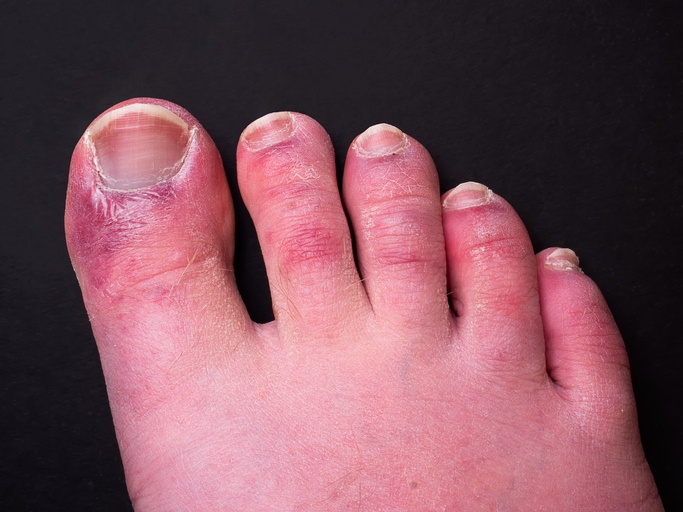
These are chilblain-like eruptions, which usually appear in milder cases of Covid-19, particularly children and young adults.6 The term ‘acral’ refers to distal extremities of peripheral body parts –fingers and toes.7 The most commonly affected site is the toes – hence the real term ‘Covid-toes’. There have been many documented case studies, which describe generally asymptomatic skin changes, which can commence with blisters, pain and erythema (redness), progressing to purplish discolouration. In around 25% of reported cases the discoloured areas are itchy.4 The development of skin conditions generally happens days or weeks following the onset of Covid-19 symptoms, some children may have been asymptomatic – so Covid-toes are a late manisfastation.8
2. Urticarial lesions
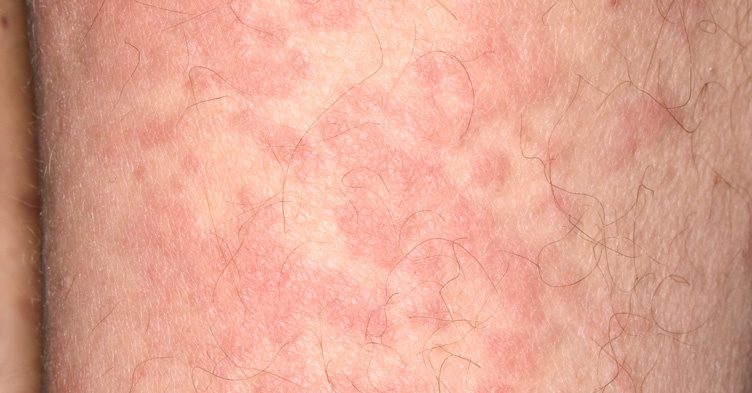
Urticaria, (‘hives’), and refers to itchy white or red lumps (wheals) that spontaneously appear on the skin, often randomly distributed over the body, in acute urticarial they often subside in 24 hours.10 Covid-19, should be considered when urticarial lesions, appear as a rash over the body, together with pyrexia. This skin sign is considered to be an early sign of infection.6
3. Maculopapular eruptions
A maculopapular eruption is described as a skin rash that contains both macules (flat discoloured areas) and papules ( raised bumps), it can be a generalised eruption. In the Spanish consensus study, 475 Covid-19 patients have a maculopapular eruptions, with half the patients also experiencing pruritus (itching). This skin sign is uncommon in children and more likely to be seen in adults with severe Covid-19 infection, with an average course of 9 days.2
4. Vesicular eruptions
These eruptions consist of vesicles, which are small itch blisters, less than 5mm, and described as chicken pox like.6 In the reported cases this eruption was either localised ( a common area was sub mammary or trunk) or generalised, and reported early in the course of COVID-19 infection.2
5. Livedo
Livedo refers to mottling of the skin, caused by underlying vascular changes. Livedo is more likely to be localised with the trunk and acral areas of the body most commonly affected.2
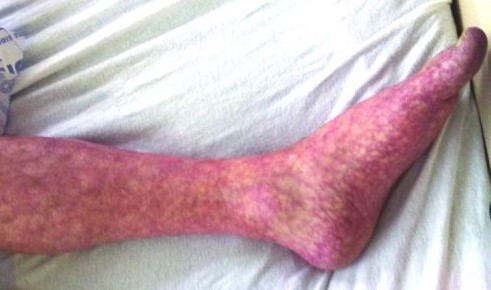
Since the publication of the Spanish consensus study2, other Covid-19 skin signs and symptoms have been reported, so the cutaneous list is dynamic and constantly being added too. Other skin symptoms include: acro-isccaemia and necrosis, petechiae and purpuris erurtions, intertriginous and flexural (skin fold) exanthema’s (viral rashes), pityriasis rosea-like eruptions, erythema-multiforme-like eruptions, unspecified erythematous facial eruptions and androgenic alopecia.4,5,6 It is wise to consider any unusual or unexpected skin eruption to be considered as a possible Covid-19 sign, even in the absence of other coronavirus symptoms.
Diagnosis and reporting of Covid-19 skin symptoms
Nurses should report any suspected Covid-19 skin signs and refer the patient to their GP, or the local dermatology department, for diagnostic confirmation. It is important to confirm a clear diagnosis of any new skin manifestations, which can be attributed to Covid-19. If Covid-19 skin symptoms are confirmed – it is possible that they may be the only symptom – then the national clinical guidance should be followed on testing and isolation9.
Treatment
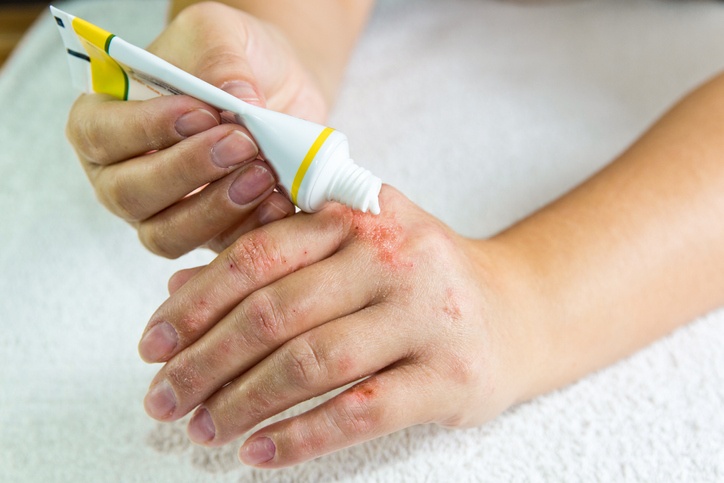
There is no specific treatment guidance for Covid-19 skin symptoms. Current treatment focuses on supportive measures. A case study of a child with Covid –toes recommended toes were kept warm with double socks and foot warmers, analgesia was prescribed but topical steroids were not indicated.8 Emollients would be advised for any inflammatory pruritic skin symptoms, emollients creams containing anti-pruritic ingredients, such as lauromacrogols and 2% menthol could be helpful to provide skin comfort and itching relief for urticarial and maculopapular eruptions.
Skin symptoms related to COVID-19 precautions.
Frequent hand washing with soap and water can result in irritant dermatitis, which is usually more severe in people with compromised skin barrier’s due to chronic inflammatory skin conditions, including eczema, psoriasis and ichthyosis. The wearing of PPE irritates skin with a hyper-hydration effect, friction which causes epidermal barrier breakdown and contact reactions, which can aggravate existing skin disease.3
Frequent hand washing with soap and water is essential to prevent the spread of Covid-19. The adverse effects of hand washing and use of sanitizer’s are caused by prolonged exposure to water, repeated use of soaps/60%+ alcohol gel and detergents on the skin and wearing of protective gloves. This can cause skin dryness, irritant contact dermatitis and allergic contact dermatitis induced by physical, chemical, and immunological mechanisms, which disrupt or remove intercellular lipids, alter epidermal keratin and increase the skin permeability and sensitivity to physical or chemical irritants.11
Hand dermatitis
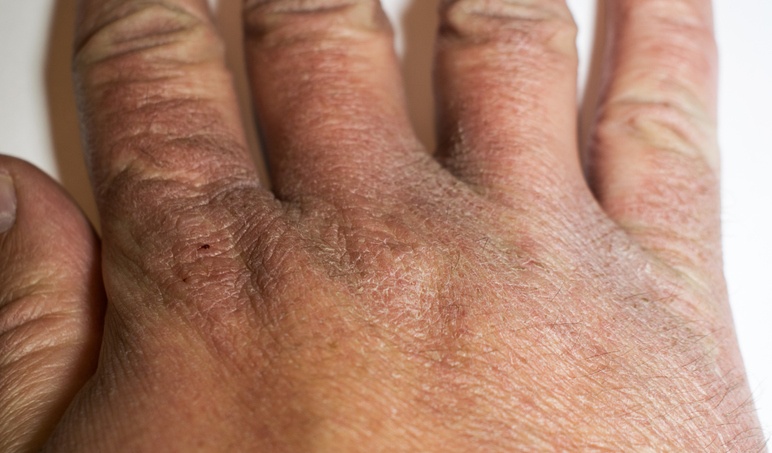
The World Health Organization recommends hands should be washed thoroughly (including fingernails, inter digital web spaces, wrists) for at least 20 seconds, using lukewarm water and soap, particularly after being in public areas, before meals, after coughing or sneezing, after using the toilet, and whenever the hands are dirty.12 If hands are becoming dry and irritated; and especially for people with eczema, the National Eczema Society advises that hands are double washed with a medical emollient cream (containing no fragrance) and then moisturised well. If hands become very dry, eczematous an sore, the use of a greasy emollient overnight with cotton gloves, will help to rehydrate and prevent irritant dermatitis.12 People who need to wear protective gloves for a long period of time, it is recommended to wash hands and apply moisturizer whenever gloves are taken off. Also, to lower the humidity, they should be changed systematically and applied only on dry hands.11 An eczematous reaction can be treated with a short course of topical corticosteroids to treat skin inflammation.13
Facial dermatitis and ‘maskne’
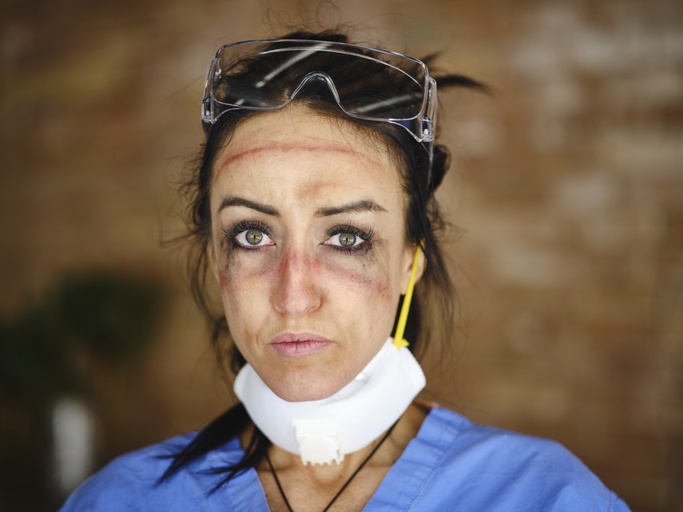
The term ‘maskne’ describes facial acne and itching, which was observed to affect one-third of health care workers wearing N95 masks.14 In addition to acne, dermatitis was a frequent skin symptom. 3 Maskne and facial dermatitis is more common in health workers due to prolonged wearing of PPE. Maskne can affect anyone who wears a mask, and aggravate existing skin conditions. Wearing masks with soft breathable fabric, e.g. cotton as the inside, layer that will absorb oily residue, can prevent facial skin irritation and maskne. Washing cotton masks daily is important to remove oil and skin cell residue, which will further aggravate maskne. Facial dermatitis may be prevented by use a protective layer of emollient (and lip balm) before wearing a mask. Cleansing and moisturising the face with bland medical emollients, after wearing a mask for a prolonged period and use a protective layer of emollient (and lip balm) before wearing a mask. Health workers should try and remove their masks, if possible during breaks, try and have a break away from the clinical area and outside.
Conclusion
This article has sought to highlight the various skin signs that may be a symptom of Covid-19. All health care professionals should be alerted to recognise these skin signs as a potential diagnostic for coronavirus infection. Patients frequently present skin symptoms to nurses in day-to day practice. The importance of skin hydration and additionally washing with emollients is an essential to prevent hand dermatitis as a consequence of frequent washing, and the detrimental effect of facial dermatitis and maskne.
References
1. NHS. Check if you or your child has coronavirus symptoms. 2020. Available at: https://www.nhs.uk/conditions/coronavirus-covid-19/symptoms/#symptoms
2. Galvan Casas C, Catalia A, Carretero Hernandez G. Classification of the cutaneous manisfestations of COVID-19: a rapid prospective nationwide consensus study in Spain with 375 cases. British Journal of Dermatology. 2020; 183: 71-77.
3. Soutou, B., Tomb, R. The Multifaceted Engagement of the Dermatologist in the Covid-19 Pandemic. SN Compr. Clin. Med. 2020: 1-5.
4. Connolly A. Cutaneous manifestations in COVID-19: a case series from a hospital in an area with high infection rates. BAD Conference Paper. 2020 On-line Virtual conference presentation.
5. Bouaziz J, Droug T, Jachiet M, et al. Vascular skin symptoms in COVID-19: a French observational study. Journal of the European Academy of Dermatology and venereology. 2020.
6. Wollina U, Karadag A, Rowland-Payne C et al. Cutaneous signs in COVID-19 patients: A review. Dermologic Therapy 2020. 6 May 2020DOI:10.111/dth.13549
7. Medical directory. Acral definition. 2020. Available at: https://medical-dictionary.thefreedictionary.com/acral
8. Mann N, Dobson J, Llewellyn J. Chilblain-like lesions during the COVID-19 pandemic in a 13-year-old schoolgirl: Case report and review of literature on cutaneous manifestations during the COVID-19 pandemic. Dermatological Nursing. Vol 19. No2. 30-34.
9. NHS. Coronavirus (COVID-19) – latest NHS information and advice. 2020. Available: https://www.nhs.uk/conditions/coronavirus-covid-19/ [accessed 30 Sept 20]
10. Urticaria. Derm Net. 2020 Available at : https://dermnetnz.org/topics/urticaria-and-urticaria-like-conditions/ [accessed 20 Sept 20]
11. Beiu C, Mihai M, Popa L, et al. Frequent Hand Washing for COVID-19 Prevention Can Cause Hand Dermatitis: Management Tips. Cureus. 2020; 12(4): e7506. doi:10.7759/cureus.7506
12. WHO. Save Lives: Clean your hands in the context of COVID-19. 2020. Available: https://www.who.int/infection-prevention/campaigns/clean-hands/WHO_HH-Community-Campaign_finalv3.pdf?ua=1 [accessed 20 Sept 20]
13. NES. Advice on coronavirus (COVID-19) for people with eczema. Available at: https://eczema.org/blog/advice-on-coronavirus-covid-19-for-people-with-eczema/ [accessed 20 Sept 20]
14. Elston DM. Occupational skin disease among health care workers during the coronavirus (COVID-19) epidemic. J Am Acad Dermatol. 2020; May, 82(5):1215-1216.






